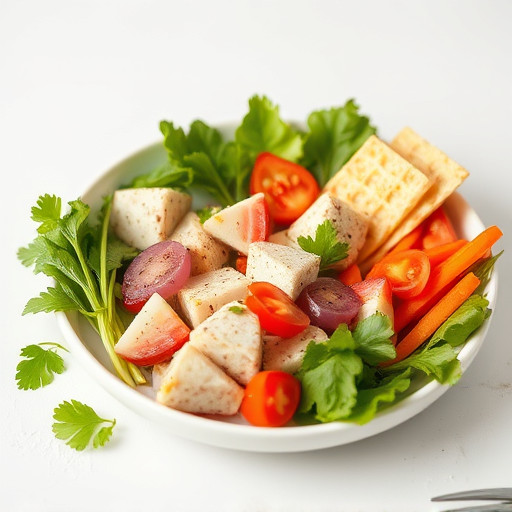Adopting a plant-based diet requires strategic meal planning, a well-stocked pantry, and time-saving techniques like meal prep. Focus on variety in vitamins, minerals, and proteins from diverse foods. Use spices to enhance flavors and health benefits. Get creative with grains, legumes, nuts, seeds, fruits, vegetables, and spices to enjoy delicious and nutritious plant-based meals.
Adopting a plant-based diet is a rewarding journey that demands thoughtful meal planning and preparation. To ensure nutritional balance, this article guides you through crafting well-rounded plant-based meals. We start by outlining strategic meal planning and introducing essential pantry staples for efficient cooking. Next, we delve into time-saving meal prep techniques, flavor-enhancing spices, and creative recipe ideas to make your transition smoother. Armed with these insights, you’ll master the art of preparing delicious and nutritious plant-based meals with ease.
- Plan Your Meals: Create a Balanced Plant-Based Diet
- Stock Your Pantry: Essential Ingredients for Plant-Based Cooking
- Meal Prep Techniques: Efficient Methods for Time-Saving
- Flavor Boosting: Plant-Based Seasonings and Spices
- Creative Ideas: Delicious Plant-Based Meal Varieties
Plan Your Meals: Create a Balanced Plant-Based Diet

When adopting a plant-based diet, planning your meals is key to ensuring a balanced and nutritious intake. Start by considering the diverse range of foods that fit within this dietary framework – fruits, vegetables, whole grains, legumes, nuts, and seeds. Aim for variety in each meal to get a wide spectrum of vitamins, minerals, and proteins. For example, combine quinoa with roasted veggies and tofu for a well-rounded dinner.
Meal planning can involve preparing a weekly schedule, shopping lists, and even cooking in batches on certain days. This systematic approach ensures you have healthy plant-based options readily available, making it easier to stick to your diet. Plus, it helps to prevent last-minute decisions that might lead to less nutritious choices or food waste.
Stock Your Pantry: Essential Ingredients for Plant-Based Cooking

When adopting a plant-based diet, having a well-stocked pantry is key to successful meal preparation. Start by filling your shelves with versatile ingredients that form the base of many dishes. Legumes like lentils, chickpeas, and black beans are excellent sources of protein and can be used in stews, salads, or as meat alternatives. Canned tomatoes, tofu, tempeh, and seitan are also staples, offering a wide range of textures and flavors for your culinary creations.
Don’t forget about grains, such as quinoa, brown rice, and oats, which provide complex carbohydrates and fiber. Herbs, spices, and oils like olive or coconut oil will add depth and richness to your dishes without the need for animal-based products. Having these essential items readily available will make meal planning and cooking much easier, allowing you to create delicious plant-based meals with ease.
Meal Prep Techniques: Efficient Methods for Time-Saving

Meal prep is an incredibly efficient way to save time and stay on track with a plant-based diet. Start by planning your weekly meals, considering balance and variety. Create a shopping list from your meal plan to ensure you have all necessary ingredients. On your designated prep day, wash and chop vegetables in bulk, cook grains and legumes, and prepare sauces or dressings. Store these components in airtight containers in the refrigerator for easy access throughout the week. Assemble your meals by combining pre-prepared elements, allowing for quick and nutritious dinners without the hassle of last-minute planning.
Flavor Boosting: Plant-Based Seasonings and Spices

Adding flavor to plant-based meals is an art, but with the right seasonings and spices, it can be a simple and delightful process. Unlike some conventional cuisines that rely heavily on meat for taste, plant-based dishes offer a unique opportunity to explore a diverse range of flavors through herbs and spices. These natural ingredients not only enhance the taste but also provide numerous health benefits.
From vibrant curries with turmeric and cumin to warm stews seasoned with bay leaves and thyme, each spice has its own character. Experimenting with different combinations can transform simple dishes into culinary masterpieces. Many plant-based cuisines, such as Indian, Moroccan, and Mexican, have rich traditions of using aromatic spices, offering a wealth of inspiration for creating flavorful meals without animal products.
Creative Ideas: Delicious Plant-Based Meal Varieties

When transitioning to a plant-based diet, one of the most exciting aspects is exploring the vast array of meal options available. Get creative in the kitchen and discover unique combinations that will tantalize your taste buds. For example, try making vibrant buddha bowls filled with quinoa, roasted vegetables, avocado slices, and a tangy tahini dressing. Another idea is to experiment with plant-based “meats” like jackfruit or seitan, which can be seasoned and used in sandwiches, tacos, or stir-fries, offering a satisfying texture and protein boost.
Don’t be afraid to mix and match different ingredients from various food groups—grains, legumes, nuts, seeds, fruits, and vegetables—to create delicious and nutritious meals. Play with flavors by combining spices like cumin, curry, or paprika, and experiment with sauces and dressings made from nut butters, tahini, or balsamic vinegar. You’ll be surprised at the variety of tasty plant-based dishes you can craft while keeping your diet exciting and enjoyable.
Adopting a plant-based diet can be a rewarding journey, offering both health benefits and culinary exploration. By planning your meals, stocking your pantry with essential ingredients, mastering meal prep techniques, enhancing flavors with spices, and embracing creative ideas, you’ll not only save time but also enjoy a diverse and nutritious range of plant-based dishes. Remember that consistent preparation and experimentation are keys to unlocking a satisfying and balanced plant-based diet.
